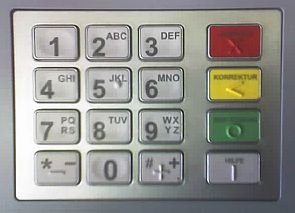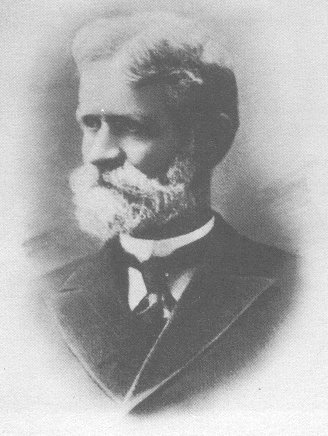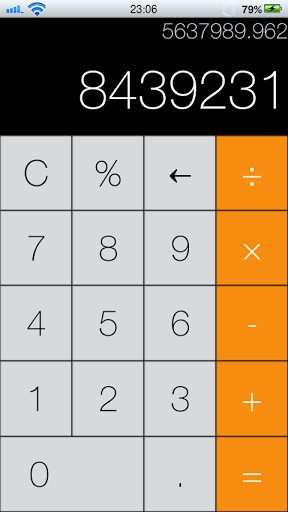0 to 9 and 9 to 0
Hello.
Have you noticed that the buttons 1, 2, 3 and 7, 8, 9 are vertically mirrored on the side computer keyboard and on the telephone keypad? But this is so, although it would seem that both of them are digital keyboards.


The reasons for the location of the buttons on the computer keyboard are, in general, intuitive: it is primarily a calculator, and it operates with numbers. Arithmetic is arithmetic, and 1 is greater than 0, and the series of numbers ends with 9, so the numbers are naturally arranged in the same order. This was back in the old days when computers were large and programs were small.

One of the first calculating keyboards from Casio Model 14A .
But the reasons for the different location of the buttons on the phone are quite curious. Here's the thing. For old phones, the dialer was disk, and on it 0 was next to 9 because of the functioning of the ten-step automatic telephone exchange: the automatic telephone exchange “caught” the open circuit when dialing a number, which occurred when dialing the number in the dialer (they are heard as clicks or “ pulses "): when dialing 1, 1 click occurred, when dialing 9 there were 9 clicks, and when dialing 0 - 10! Therefore, the telephone exchange is called "decade". Accordingly, with each click (or “pulse”), the arrow in the special device on the PBX moved to the next position, and the desired number was dialed. Therefore, such a telephone exchange is called "stepping." In fact, a ten-step automatic telephone exchange is much more complicated, it’s a hell of an electromechanical device,
With the arrangement of numbers, everything here becomes clear: 10 is greater than 9, so 0 should be located next to 9 simply because of the technical solution of the dialer as a device for generating pulses. It should be noted that in New Zealand and Sweden they nevertheless tried to follow the voice of reason and put 0 next to 1 on disks, but somehow these decisions did not take root.

Warmtube dial dialer.

Phone from my childhood.
When, along with automatic telephone exchanges operating in tone dialing mode, button dialers appeared, they were equipped with a switch to the "pulse" dialing mode, and, naturallyso that, God forbid, users do not have to relearn (and this is really real stress for many), they put 0 on the keyboard next to 9. But not by transferring 0 (which, perhaps, would be easier), but by changing the arrangement of rows keys {1, 2, 3} and {7, 8, 9}. Here I can only guess, but I dare to assume that this was done to unify the keyboards and boards in them with calculators, because for sure (at least at first) the keyboards and boards for phones were ordered from manufacturers of calculators, fortunately, the dimensions were the same.

Familiar to all the modern look of the phone.
This story was continued in a rather unexpected industry: when ATMs began to appear, they had numeric keypads installed, and since almost everyone who was in the target audience of users of new devices had a telephone at that time, it was still a very long time before personal computers , then, of course , the ATMs received a keyboard with a telephone key arrangement.

Dial pin to withdraw salary.
And now - the most delicious. Where did the disc dialer come from?
Invented the automatic dialing system in 1891, a resident of Kansas City Elmon Strowger. He was the owner of a funeral home, and the competitor’s wife was a young lady at a local telephone exchange.. This lovely lady, of course, passed on all the calling customers to her husband. The first automatic telephone exchange of the Stroudger design was launched in 1892. She received the nickname "no dames'n'damns telephone", that is, a phone without young ladies and curses. I endlessly admire this man. How much do we know the owners of funeral homes, transforming and just throwing the whole industry forward? But the invention is very serious.

Mr. Strawger himself.

Strawger switch, still without an electromagnet.
So in this way, due to competition in the funeral business in the 19th century in the middle of the USA, we now have two standards for digital keyboards on now similar devices. It looks especially funny on smartphones:


Thanks to Wikipedia for the illustrations.
Have you noticed that the buttons 1, 2, 3 and 7, 8, 9 are vertically mirrored on the side computer keyboard and on the telephone keypad? But this is so, although it would seem that both of them are digital keyboards.


The reasons for the location of the buttons on the computer keyboard are, in general, intuitive: it is primarily a calculator, and it operates with numbers. Arithmetic is arithmetic, and 1 is greater than 0, and the series of numbers ends with 9, so the numbers are naturally arranged in the same order. This was back in the old days when computers were large and programs were small.

One of the first calculating keyboards from Casio Model 14A .
But the reasons for the different location of the buttons on the phone are quite curious. Here's the thing. For old phones, the dialer was disk, and on it 0 was next to 9 because of the functioning of the ten-step automatic telephone exchange: the automatic telephone exchange “caught” the open circuit when dialing a number, which occurred when dialing the number in the dialer (they are heard as clicks or “ pulses "): when dialing 1, 1 click occurred, when dialing 9 there were 9 clicks, and when dialing 0 - 10! Therefore, the telephone exchange is called "decade". Accordingly, with each click (or “pulse”), the arrow in the special device on the PBX moved to the next position, and the desired number was dialed. Therefore, such a telephone exchange is called "stepping." In fact, a ten-step automatic telephone exchange is much more complicated, it’s a hell of an electromechanical device,
With the arrangement of numbers, everything here becomes clear: 10 is greater than 9, so 0 should be located next to 9 simply because of the technical solution of the dialer as a device for generating pulses. It should be noted that in New Zealand and Sweden they nevertheless tried to follow the voice of reason and put 0 next to 1 on disks, but somehow these decisions did not take root.

Warm

Phone from my childhood.
When, along with automatic telephone exchanges operating in tone dialing mode, button dialers appeared, they were equipped with a switch to the "pulse" dialing mode, and, naturallyso that, God forbid, users do not have to relearn (and this is really real stress for many), they put 0 on the keyboard next to 9. But not by transferring 0 (which, perhaps, would be easier), but by changing the arrangement of rows keys {1, 2, 3} and {7, 8, 9}. Here I can only guess, but I dare to assume that this was done to unify the keyboards and boards in them with calculators, because for sure (at least at first) the keyboards and boards for phones were ordered from manufacturers of calculators, fortunately, the dimensions were the same.

Familiar to all the modern look of the phone.
This story was continued in a rather unexpected industry: when ATMs began to appear, they had numeric keypads installed, and since almost everyone who was in the target audience of users of new devices had a telephone at that time, it was still a very long time before personal computers , then, of course , the ATMs received a keyboard with a telephone key arrangement.

Dial pin to withdraw salary.
And now - the most delicious. Where did the disc dialer come from?
Invented the automatic dialing system in 1891, a resident of Kansas City Elmon Strowger. He was the owner of a funeral home, and the competitor’s wife was a young lady at a local telephone exchange.. This lovely lady, of course, passed on all the calling customers to her husband. The first automatic telephone exchange of the Stroudger design was launched in 1892. She received the nickname "no dames'n'damns telephone", that is, a phone without young ladies and curses. I endlessly admire this man. How much do we know the owners of funeral homes, transforming and just throwing the whole industry forward? But the invention is very serious.

Mr. Strawger himself.

Strawger switch, still without an electromagnet.
So in this way, due to competition in the funeral business in the 19th century in the middle of the USA, we now have two standards for digital keyboards on now similar devices. It looks especially funny on smartphones:


Thanks to Wikipedia for the illustrations.
